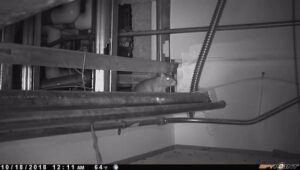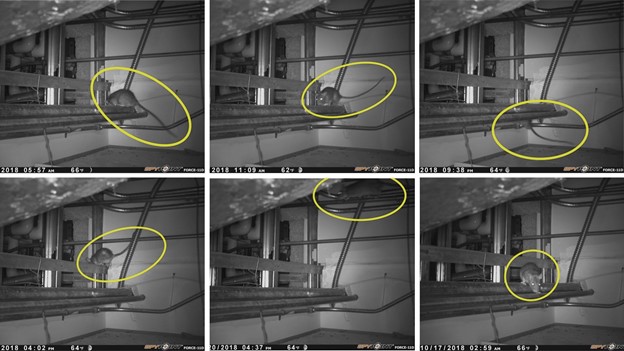Cameras Expand the Vision of Your Rodent Management Program
A picture tells a thousand words and when it comes to rodent management and cameras the next chapter in rodent control is being written in images. Cameras give pest management professionals and their clients access to the secretive world of rodents.

Cameras can monitor rodent activity 24/7 in hard to access areas of a structure including drop ceilings, beams and pipes. This helps track rodent movements, identify access points and food sources, all the while providing a unique look into the daily lives of rodents.
Cameras can monitor rodent activity 24/7 in hard to access areas of a structure including drop ceilings, beams and pipes. This helps track rodent movements, identify access points and food sources, all the while providing a unique look into the daily lives of rodents.
On a recent Sprague webinar Ashley Roden, B.C.E., technical manager, discussed why cameras are rapidly becoming a valuable tool in the fight against persistent rodent infestations.
“Rodents have well developed senses of smell, touch and hearing and live within tight colony structures,” said Roden. “Each colony behaves differently when it comes to what they eat, where they travel and where they live.”
For example, young rodents learn behaviors from their mothers on how to avoid traps while searching for food and cameras capture these moments and provide valuable insights for designing management programs.
“Rodent programs need to be as unique as the rodents, and cameras provide us with information that allow us to design customized control programs that suit the specific needs of the clients and the situation,” added Roden.
Why Sprague Uses Cameras
The installation of cameras in a commercial facility dealing with a rodent issue is done for the following reasons:
- Constant monitoring
- Confirmation of elimination of the rodent(s)
- Entry to inaccessible areas for monitoring and inspection
- Gathering behavioral information
Rodents are neophobic – they are afraid of anything new in their world – and this drives how the professional pest management industry approaches rodent management. For this reason, the placement of rodent management equipment – traps, bait and tracking stations, and now cameras – is key.
Cameras have shown rats and mice eating from and climbing over traps without setting them off or avoiding them all together. Roden said it can take a month or two for rodents to accept a new device. Oddly, enough rodents have shown greater acceptance of cameras into their nocturnal world.
The rodent behaviors learned from cameras include:
- Trap avoidance
- Camera non-avoidance
- Travel paths
- Interaction with colony members
- Grooming and eating habits
Smile for the Camera
Roden cited an instance where Sprague used a camera in a garbage room of a downtown structure facing a tough mouse infestation to help deliver a solution.
A large gap in one of the building’s overhead doors was allowing some rodent movement into the building, but there was an established population already in the building and plenty of available food. Traps were set in the garbage room to knockdown the population, but the mice were still there.
Looking for a solution, Sprague installed a camera in the garbage room in hopes of gleaning additional information on the mice’s behavior. The camera provided a visual log of the mice’s movements; how they were traveling within the room and avoiding the traps. Based on the visual evidence, the technician was able to adjust the trap placement and achieve the desired results (Sprague also advised the client to correct the door opening).
The takeaways from using a camera in this account included:
- Device placement and clustering is very important.
- Rodent control needs to be three-dimensional – walls, ceiling and floor.
- Multi-catch traps weren’t enough for control.
- Mice can be just as hard to control as rats.
“Cameras connect Sprague with rodent behavior to better understand how to control them,” said Roden. “Rodents will use pipes, beams, wires and textured walls on the interior and exterior to move about and cameras are sometimes the only way to capture that movement.”
Realistic Expectations
Simply adding cameras to a client’s rodent management program will not solve the problems. A camera is just one spoke in the wheel of integrated rodent management that also includes inspections, monitoring, sanitation and exclusion practices.
“Just because you see them on camera doesn’t mean you will catch them all in one day or one week,” said Roden. “Conversely if you don’t see rodent activity on camera, it doesn’t mean there are no rodents present. Cameras help expand your vision for your rodent management program and look beyond devices.”
Discover The Sprague Difference
Looking for innovative rodent management solutions from an innovative pest management partner? Connect with the rodent management experts at 800.272.4988.

